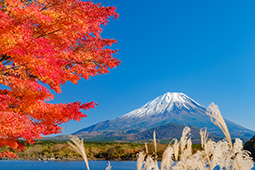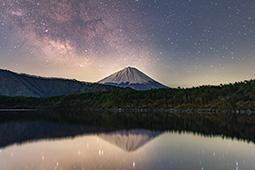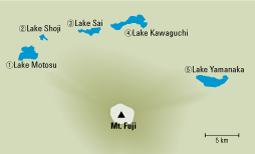January 2023
- English
- 日本語
The Allure of the Fuji Five Lakes, a World Heritage Site

Double Diamond Fuji seen from the shores of Lake Yamanaka (map⑤) 
People fishing on Lake Kawaguchi (map④)

People kayaking on Lake Motosu (map①) 
Autumn leaves by Lake Shoji (map②) 
A starry sky over Lake Sai (map③) 
Map of the Fuji Five Lakes

The five lakes along the northern foothills of Mt. Fuji are known as the Fuji Five Lakes. All year round, many people visit this area close to the mountain and its lakes, where they can enjoy fishing, camping, trekking, hot springs and more.

In the northern foothills of Mt. Fuji are the Fuji Five Lakes, an area known for the five lakes of its name. The lakes, from west to east, are Lake Motosu, Lake Shoji, Lake Sai, Lake Kawaguchi, and Lake Yamanaka. A part of Fuji-Hakone-Izu National Park*, each of the lakes is a component part of the Mt. Fuji World Heritage site. A long time ago, there were several large lakes around Mount Fuji. It is believed that the current five lakes were formed as these large lakes were separated and filled with lava flow following several eruptions of Mt. Fuji.

“A major allure of the Fuji Five Lakes is surely the wonderful views of towering Mt. Fuji as their background,” says Ueno Yukichi, Executive Director of the Fuji Five Lakes Tourism Federation. “And as each of the five lakes has different topography and different surrounding scenery, we can enjoy a taste of the unique views of each lake.”

The lakes are close to the Tokyo metropolitan area, and are all easily accessed by train and bus, making them a tourist area for relaxed fun. There are many great spots for cherry blossoms and autumn leaves in particular, and in spring and autumn, visitors can enjoy the exciting interplay between these seasonal displays and Mt. Fuji itself. Fishing, kayaking and wind surfing can also be enjoyed at each of the lakes. In the surrounding areas, visitors can enjoy trekking and hot springs, and there are many ski slopes, skating rinks, camping sites, other outdoor leisure facilities, as well as art museums and other museums. It would be impossible to grow tired of the area no matter how many times you visit each season.

Visitors can also enjoy the sight of Mt. Fuji reflecting off the surface of the lakes, and at certain times throughout the year it’s possible to encounter a rare sight. “I think this is something special you can’t find anywhere else,” says Ueno. This sight is called the ‘Diamond Fuji,’ which occurs when the rising or setting sun appears to shine like a diamond the moment it aligns with the peak of Mt. Fuji. An even more rare sight is known as the “Double Diamond Fuji,” which is when the sun, shining like a diamond at the mountain summit, is reflected on the surface of the lake below. Among the five lakes, this phenomenon is only visible at sunset from the middle of October to the end of February at Lake Yamanaka, and at sunrise from late December to early January at Lake Motosu, weather conditions permitting.

Ueno explains the relationship between the Fuji Five Lakes and worship of the mountain that offers this mystical sight. “The Fuji Five Lakes played an important role in Fuji-ko**, a folk belief that was popular for around 300 years from the 17th century. Fuji-ko practitioners made pilgrimages to the Fuji Five Lakes or the nearby Oshino Hakkai springs (see here) to purify their minds and bodies, and afterwards they would head up the sacred mountain to pray.” With this historical background, the Fuji Five Lakes were inscribed as a UNESCO World Heritage site in 2013, one of the component parts of “Fujisan, sacred place and source of artistic inspiration.”
A trip to the Fuji Five Lakes to experience the mystique of Mt. Fuji, which was also an object of worship for Japanese people, is highly recommended.
- * See Highlighting Japan January 2018, “In the Foothills of Mount Fuji” https://www.gov-online.go.jp/eng/publicity/book/hlj/html/201801/201801_13_en.html
- ** A religious group made up of people who worshiped Mt. Fuji

